Exotic ship designs in the era of steam
The steam engine became the harbinger of a radical revolution in shipbuilding. The composition of the military fleets of many countries begins to appear the first ships with a steam engine. Initially, these were parachodofrigates. The first of these, Medea, was built in the UK in 1832. The ship combined a steam engine with a wheeled mover and sailing weapons. The invention of the bombing cannons by the French general Henri-Joseph Peksan became the second messenger of radical changes at sea. Bomb guns that fired large-caliber explosive shells along the trajectory put an end to the entire sailing navy. If before their invention naval battles between two ships could go on for hours, explosive bombs filled with black powder could cause catastrophic damage to a wooden ship in minutes of battle.
The very first use of bomb bombers in battle during the war between Denmark and Prussia in 1849 showed that the era of sailing ships, which lasted almost two thousand years, had come to an end. Prussian coastal batteries, which were equipped with Peksan guns, successfully shot at the Danish ships. They set fire to and forced two large ships to be thrown ashore - the 84-gun battleship "Christian VIII" and the 48-gun frigate "Gefion". In this case, the Danes lost 106 people killed, 60 - wounded, and 948 team members were captured. The famous Sinop battle between the Russian Black Sea fleet and the Ottoman squadron again proved that new times were coming.
Bombing guns that were on the ships Nakhimov, said their weighty word, the Turkish squadron was utterly defeated: the Turks lost 9 large ships (7 frigates and 2 corvette) and about three thousand people were killed and wounded, while Nakhimov lost all the 37 people killed.
The news of the Battle of Sinop quickly reached Europe and the North American States. Admirals around the world made their conclusions - the ships needed to be protected with armor. This was understood most quickly in France, which used armored floating batteries as early as the Crimean War. In the USA, they took another step forward, during the years of the Civil War, monitors were very widely used here, albeit with dubious booking and disgusting seaworthiness. Finally, in the UK, in 1860, the first in the history steam armadillo was built, which had an all-metal hull. The ship was called the "Warrior", a year later its sistership "Black Prince" was built. These armadillos retained their sailing armament, but were already ships of the next generation. These two ships, which were the strongest on the planet at that time, did not withstand the pressure of the steam and electricity epoch, they became outdated in just one decade.
HMS Captain
Until the last quarter of the XIX century, the presence of guns in the towers was a specific sign of coastal defense ships, which rarely departed far from the port of registry. The main problem at that time was the imperfection of the first steam engines. Their breakdown at the moment when the battleship was in the ocean could become a serious problem. It was for this reason that the ocean ships were still trying to equip with sailing armament. At the same time, masts and sails were not allowed to use tools in the towers. Taking this into account, a very specific ship was created in the UK, called the HMS Captain (1869). The ship was launched on 27 March 1869 of the year, in April 1870 of the year the ship was put into operation, but did not serve for long, after six months he sank along with the entire crew.
This project was the brainchild of Captain First Rank and engineer Cooper Phips Kolz, who patented a rotating gun turret in 1859, possibly becoming a pioneer in this field. The tower battleship designed by him was to be the pinnacle of the progress of his years. The installation of rotating towers on the ship significantly increased its firepower, making it easy to carry out a "maneuver by fire". The project proposed by Kolz for a nautical spar tower battleship with a low freeboard height (approximately 3,4-3,5 meters) and the installation of two two-gun towers with the most powerful guns of 305-mm caliber pleased the Admiralty. Each of the two towers weighed 112 tons and turned manually.
At that time, Cooper Phips Kozl was already considered an experienced and reputable shipbuilder, so his project was supported. However, there were objections that were not heard, which led to the imminent tragedy. Edward Reid, director of naval construction, smashed the project to pieces, noting that the battleship battleships (Cooper wanted to retain the rigging) are already yesterday and archaic, because of the enormous weight of the match, the sails and gear will be very bad, and the center of gravity of the vessel will be much higher than common sense would require. Reed was absolutely right, but they did not listen to him.
The tower battleship sounds good, but in fact the ship looked very strange. Above the upper deck, where two towers with four 305-mm guns were installed, there was a suspended false-deck, which went from the bow to the stern of the ship. She relied, respectively, on a forecastle and flight, which reduced the shelling sector of tower guns. Therefore, one 178-mm gun was installed on the bow and stern of the ship. All work team with rigging were on the raised deck, in order not to interfere with the gunners. The appearance of this canopy over the towers even more raised the center of gravity of the ship. Moreover, the battleship, which had a solid armor belt along the entire length of the hull, turned out to be over-weighted. When launched, its draft exceeded the design one by 33 centimeters. The crew of the ship instead of the design 400 man made 500, which also added weight to the ship. The total overload of the ship, according to various estimates, ranged from 730 to 830 tons, and the total roll in 14 degrees was enough to cut the deck of the ship on the water level. The three masts with sails with a total area of 4650 square meters, which fully corresponded to the armament of the good old wooden battleship, did not add any advantages to it, which further aggravated the already very poor stability.
Despite this, Captain was adopted, he was able to demonstrate excellent speed characteristics and maneuverability. Bribed the military and the power of its artillery weapons, as well as excellent armor, for example, booking towers ranged from 229 to 254 mm. Although the accuracy of his 12-inch guns, like all heavy guns of those years, it was impossible to say anything good. During his last trip to the sea, the Capten held firing exercises near Vigo. Together with two other battleships, he fired 12 shots at a cliff, which in its size resembled a ship. From a distance of one kilometer, the ships were able to achieve only one direct hit on the rock.
If the ship were used only for the tasks of coastal defense, the tragedy would not have happened, but it was not destined to sail to relatively calm waters near the coast. HMS Captain sank on the night of 6 on 7 September 1870 of the year during a heavy storm that began at the moment when the English squadron was returning home from a hike in the Mediterranean. The tragedy happened around 20 miles from Cape Finnisterre, the most westerly point of Spain. The English battleship rolled over and sank in literally 30-40 seconds. Of the entire crew, only 18 people survived, with only one sailor able to get out of the ship’s interior. The remaining survivors were on the upper deck or worked with the spars. Almost the 500 man and his creator Cooper Phipps Koz, who took part in the march to control his brainchild, sank with the ship. It is noteworthy that, in addition to the Captan, not a single ship of the English squadron was harmed by this storm.
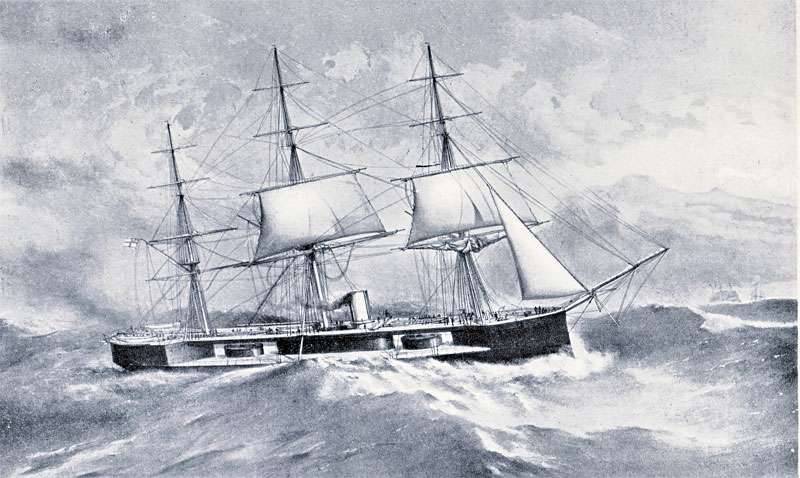
Italian gunboats with 400-mm guns
Gunboats evolved into a class of warships many years before the onset of the steam era. It was a class of small combat ships with artillery weapons. They were intended for combat operations on lakes, rivers, as well as in coastal sea areas, to protect harbors. And in 1887, the British shipyard Armstrong Mitchell & Company, located in Elswick, received an order for the construction of two ordinary gunboats for Italy - a displacement of 687 tons, a length of 35 meters, a width of 11 meters. They were equipped with one 261 kW steam engine. The gunboats were named "Castore" and "Polluce".
These would be unremarkable small warships with a crew of 49 people and speeds of 8 knots, if it were not for the Italians to install an 400-mm gun on them. Yes, yes, it is the 400-mm Krupp gun. Italians obviously were not going to bother talking. In this case, it was about any mortar, but about a full-fledged 400-mm gun with a barrel length of approximately 30 calibers. With a displacement of 687 tons, the weight of the gun mounted on the gun was about 120 tons. Naturally, it was not about any tower or mechanisms of guidance, judging by the photographs that have survived to our day, the instrument naturally occupied half of the ship, while all the superstructures were crowded in the bow. There was no auxiliary weapon on the gunboats, there was simply no room for it.
Why the Italians went for this shaped madness is hard to say. However, the 400-mm cannon mounted on the cannon apparently did fire. The ship did not fall apart and did not sink. For several years, the admirals of the Italian fleet could not come up with a reasonable scheme for using such an unusual combination of a ship and weapons. In the end, in 1899, both gunboats armed with much more sane 120-mm guns and a pair of machine guns. In this form, they served until their cancellation. The “Castore” cannon lasted until the 1925 year, and the “Polluce” was written off already in the 1911 year.
Monitor "Faa di Bruno"
Continuing the conversation about the Mediterranean fleet delights, we can note another very exotic project of the Italian fleet. It will be about the monitor "Faa di Bruno." This seemingly unusual ship in 1915 was designed by the famous Italian shipbuilder Giuseppe Rota. Looking at the photos of this monitor, it may seem that it has already been sunk, but it is not.
Structurally, this monitor, which became the crown of the development of floating batteries in Italy, was a rectangular pontoon, which had a sloping "gable" deck and a blunt upturned nose. The guns were placed in a kind of, partially movable turret, which allowed firing in a fairly narrow sector of the ship's course. In addition to the weapon mechanisms, and ammunition, only small boilers and vehicles from the old destroyer could be installed in a small monitor case. All this, combined with the very bad hydrodynamics inherited from the pontoon, limited the speed of the Fa di Bruno monitor to a miserable three nodes. The ship definitely did not work, but the gun platform, if it didn’t have to go anywhere, was good.
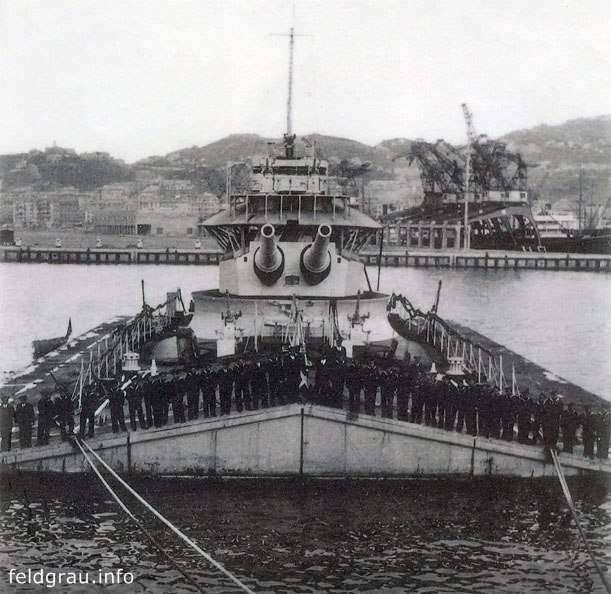
The 381-mm guns, which were originally made for the unfinished battleship Cristoforo Colombo, had a shelling sector of 60 degrees and an elevation angle of 15 degrees. Compared to the UK monitors of those years, the Italian was very slow, but had a very small draft (no more than 2,2 meters), which significantly reduced the risk of detonation on the mine and allowed the monitor not to be afraid of shoals. They built a ship for a long time, almost two years. This was due to significant problems with the installation of heavy duty guns on a fairly small ship (maximum displacement of 2800 tons). The Faa di Bruno monitor was commissioned only in the middle of summer 1917. At the same time, in November of the same year, the combat career of the ship was interrupted. Possessing a disgusting seaworthiness, he fell into a storm and had to throw himself ashore near Ancona, where his participation in the First World War was over.
From the side of this Italian monitor looked at least unusual. From a distance, it would seem that only a tower with two huge 15-inch guns and a three-legged mast floats across the sea. Only after looking closely, it was possible to consider the hull, which was almost completely hidden under water, yet pontoon roots had an effect. At the same time, after the end of the First World War, the monitor was restored, and he even took part in the Second World War, providing Genoa artillery cover under the designation “GM 194 floating battery”.
Information sources:
http://warspot.ru/3528-kazusy-epohi-para-i-elektrichestva-ekstremalnoe-korablestroenie
http://kettenkrad.livejournal.com/130943.html
http://forum.worldofwarships.ru/index.php?/topic/1200-броненосец-капитан
http://ship.bsu.by/ship/103298
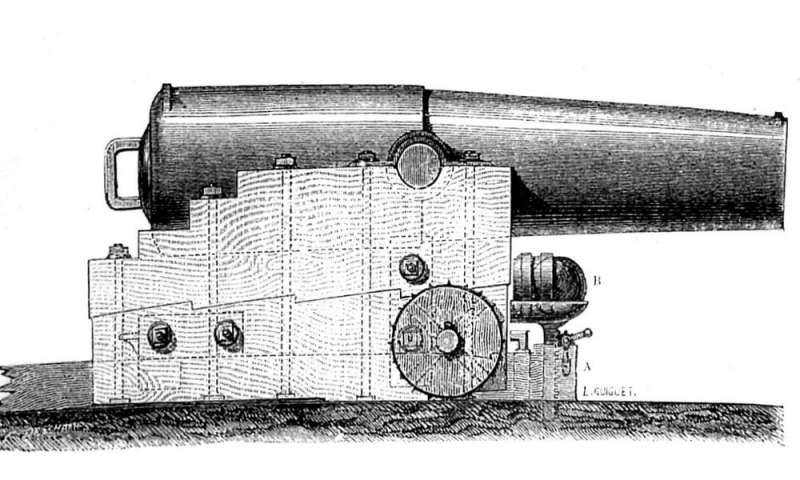
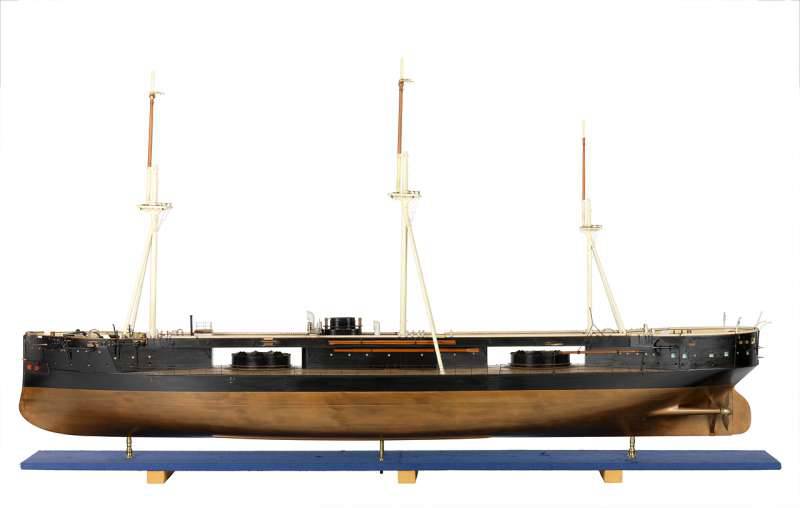
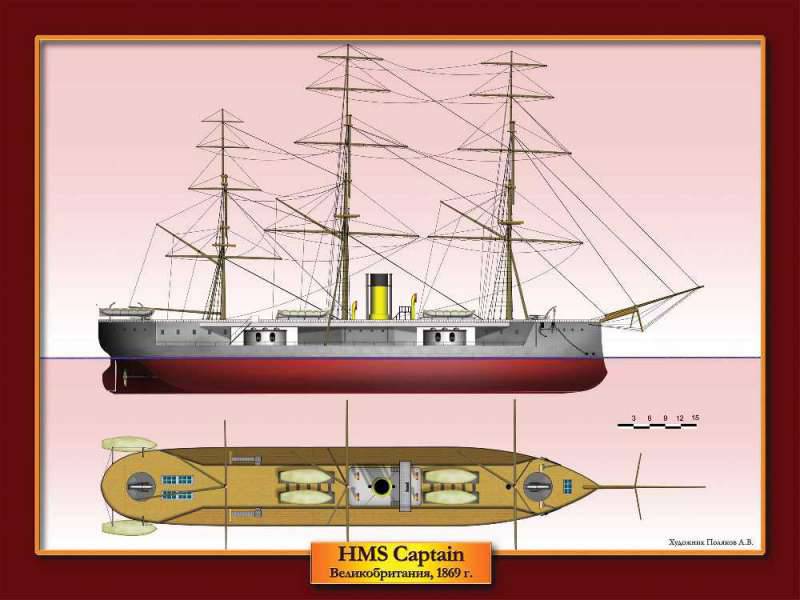
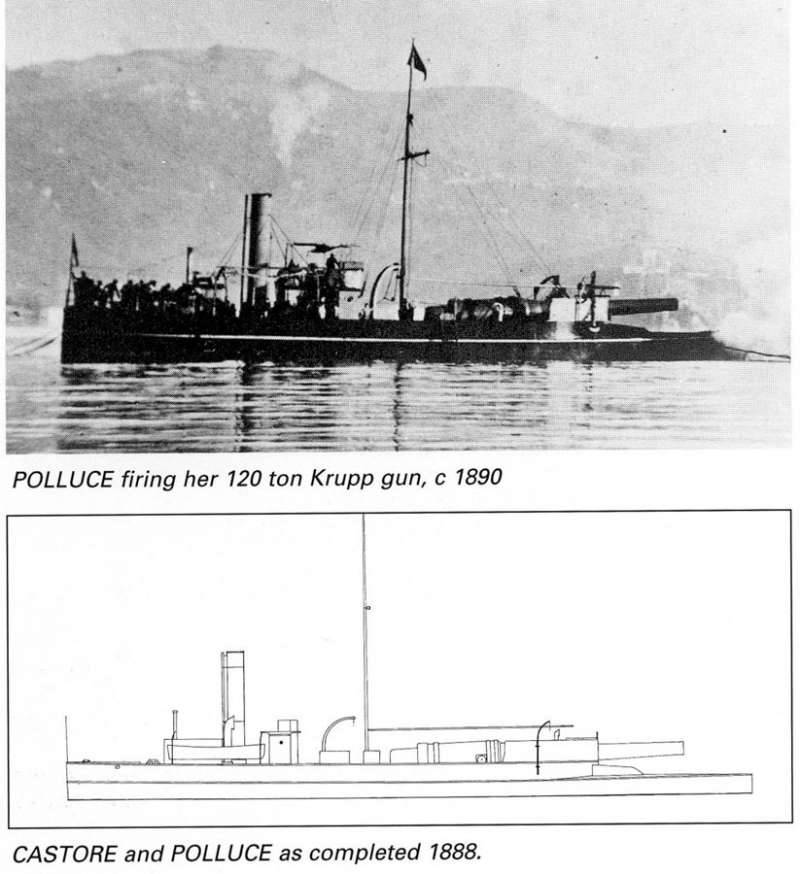
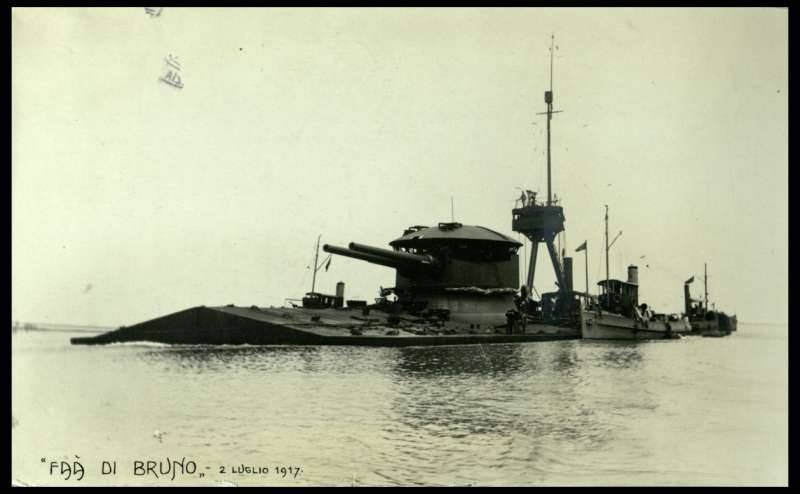
Information